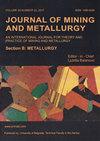Antimony recovery from recycled terminals of lead-acid batteries with Na2CO3 and SiC after firstly SsB2O3 formation
IF 1
4区 材料科学
Q3 METALLURGY & METALLURGICAL ENGINEERING
Journal of Mining and Metallurgy Section B-Metallurgy
Pub Date : 2021-01-01
DOI:10.2298/jmmb210616052j
引用次数: 2
Abstract
Terminals obtained from spent lead-acid batteries in Mexico contain around 2 wt% Sb. The terminals were melted in an electric furnace and then oxygen was injected to 750?C and a gas flow rate of 2 L/min to produce high purity Sb2O3. The antimony trioxide obtained was treated with a mixture of Na2CO3-SiC to 1000?C to obtain metallic antimony. The antimony trioxide is reduced by the C present in reagents while silicon and sodium form a slag phase. The amounts of Sb2O3 and SiC were held constant while the Na2CO3 was evaluated in the range from 30 to 42 wt%. The antimony and slag produced were characterized by X-ray diffraction and SEM-EDS techniques. The addition of 34 wt% Na2CO3 leading the recovery of antimony up to 90.16 wt% (99.57 wt% purity) and the lowest antimony losses in the slag (2 wt%). In addition, the compounds Na2SiO3 and Na2Si2O5 formed in the slag may indicate a more stable slag. Na2CO3 contents higher than 38 wt% decreased the antimony recovery since it promotes the Na2Sb4O7 compound in the slag. The oxidation and reduction process was modeled in FactSage 7.3 software for a better understanding of the Na2CO3 and SiC additions on the antimony recovery rates and compounds formed in the slag.先生成SsB2O3后,用Na2CO3和SiC回收铅酸电池端子中的锑
从墨西哥的废铅酸电池中获得的接线端子含有约2wt % Sb。接线端子在电炉中熔化,然后注入氧气至750?温度为C,气体流速为2l /min,可制得高纯度Sb2O3。所得的三氧化二锑用Na2CO3-SiC至1000?C得到金属锑。三氧化二锑被试剂中存在的C还原,而硅和钠形成渣相。Sb2O3和SiC的含量保持不变,而Na2CO3的含量在30%到42%之间。用x射线衍射和扫描电镜能谱仪对锑和渣进行了表征。添加34 wt%的Na2CO3可使锑的回收率达到90.16 wt%(纯度为99.57 wt%),且渣中锑的损失率最低(2 wt%)。此外,渣中形成的Na2SiO3和Na2Si2O5化合物可能表明渣更稳定。Na2CO3含量高于38%会促进矿渣中的Na2Sb4O7化合物,从而降低锑的回收率。为了更好地了解Na2CO3和SiC添加对锑回收率和渣中形成的化合物的影响,在FactSage 7.3软件中对氧化还原过程进行了建模。
本文章由计算机程序翻译,如有差异,请以英文原文为准。
求助全文
约1分钟内获得全文
求助全文
来源期刊
CiteScore
2.00
自引率
40.00%
发文量
19
审稿时长
2 months
期刊介绍:
University of Belgrade, Technical Faculty in Bor, has been publishing the journal called Journal of Mining and Metallurgy since 1965 and in 1997 it was divided in two independent journals dealing with mining and metallurgy separately. Since 2009 Journal of Mining and Metallurgy, Section B: Metallurgy has been accepted in Science Citation Index Expanded.
Journal of Mining and Metallurgy, Section B: Metallurgy presents an international medium for the publication of contributions on original research which reflect the new progresses in theory and practice of metallurgy. The Journal covers the latest research in all aspects of metallurgy including hydrometallurgy, pyrometallurgy, electrometallurgy, transport phenomena, process control, solidification, mechanical working, solid state reactions, materials processing, surface treatment and relationships among processing, structure, and properties of materials.

 求助内容:
求助内容: 应助结果提醒方式:
应助结果提醒方式:


